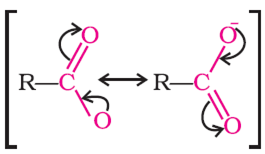 Short Answer Type
Short Answer TypeWhy is benzaldehyde is less reactive than acetaldehyde towards nucleophilic addition reactions?
Account for the following:
(i) Formaldehyde gives Cannizzaro’s reaction whereas acetaldehyde does not.
(ii) Carboxylic acids do not give characteristic reactions of carbonyl compounds.
i) Aldehydes which have an alpha hydrogen atom does not give cannizzaro's reaction. Acetaldehyde, CH3CHO has 3 hydrogens but in case of formaldehyde, HCHO there is no alpha hydrogen present , hence formaldehyde undergoes cannizzaro's reaction where as acetaldehyde does not.
ii) Caroboxylic acids do not give characteristic reaction of carbonyl compounds. This is because the lone pairs on oxygen atoms attached to hydrogen atom in the –COOH group are involved in resonance there by making carbon atom less available.
Account for the following:
(i) Chloroacetic acid has higher pKa value than acetic acid.
(ii) Electrophilic substitution in benzoic acid takes place at meta position.
(iii) Carboxylic acids have higher boiling points than alcohols of comparable molecular masses.
 Long Answer Type
Long Answer TypeHow would you obtain the following named sources:
(i) Tertiary butyl alcohol from acetone? (ii) Acetone from acetic acid?
Mention conditions for reactions involved.
 Short Answer Type
Short Answer TypeExplain why O-hydroxy benzaldehyde is a liquid at room temperature while p- hydroxy benzaldehyde is a high melting solid.
